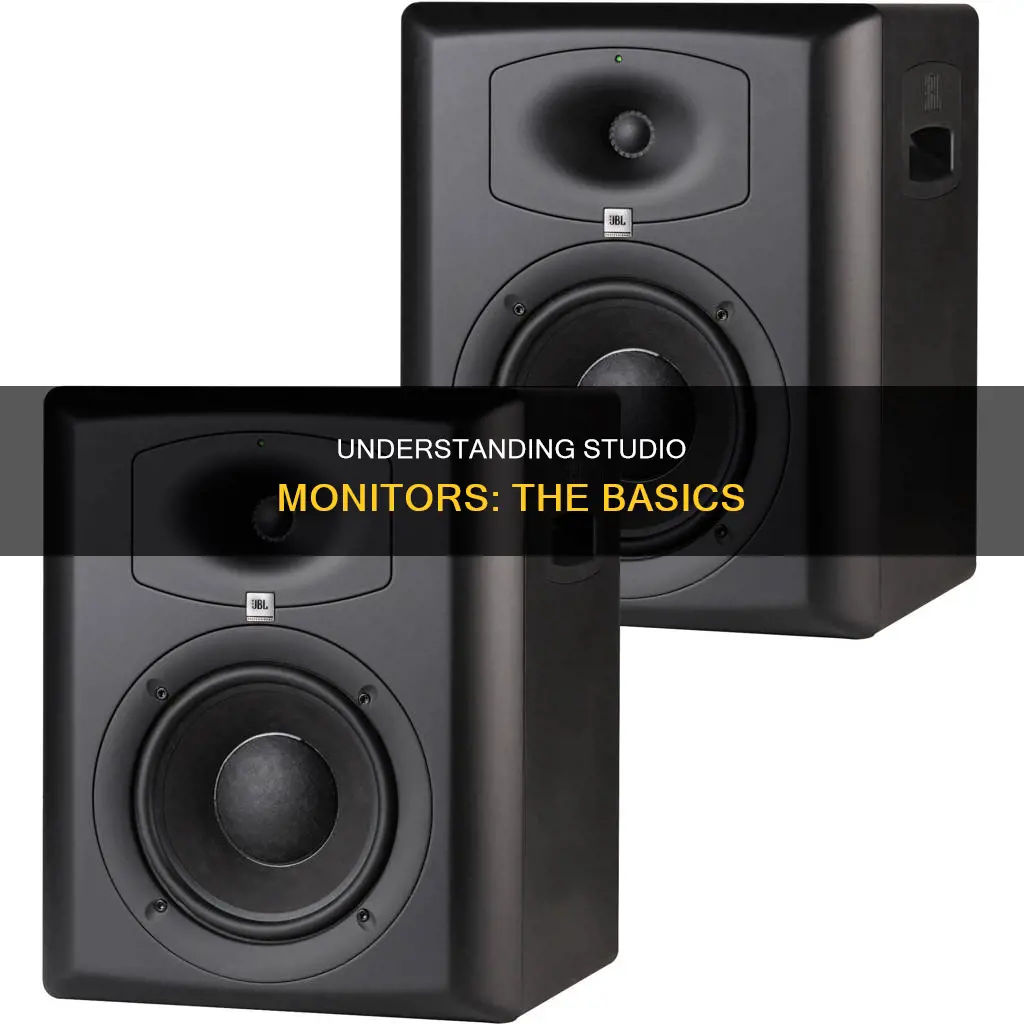
Studio monitors are loudspeakers designed for professional audio production applications, such as recording studios, filmmaking, television studios, radio studios, and home studios. They are used to mix music, dialogue, and sound effects during the recording, mixing, and mastering processes. Studio monitors are designed to have a flat frequency response, meaning all frequencies are played at the same volume level, allowing for accurate balancing of different frequencies in the audio. This is important when mixing to ensure the final product sounds good on a variety of playback systems, from high-end stereos to car radios and smartphones. Studio monitors can be active, with built-in amplifiers, or passive, requiring external amplifiers. They come in different sizes, with larger monitors suited for bigger studio environments, and can be placed on stands or mixing consoles, typically at the listener's ear height.
What You'll Learn

Studio monitors are used for analytical hearing
Studio monitors aim for a flat frequency response, meaning all frequencies are played at the same volume level. This is in contrast to regular Hi-Fi speakers, which emphasise certain frequencies, such as adding more bass or treble, to create an enhanced listening experience. With studio monitors, engineers can be sure that they are hearing an accurate representation of the sound and can make informed decisions about the audio mix.
The accuracy of studio monitors is further enhanced by their placement and listening position. They are usually placed on stands or a mixing console, with the listener seated a few feet away, ensuring a relatively neutral listening environment. This setup minimises sound bouncing off walls or other surfaces, which could distort the sound.
Studio monitors are also designed to handle the high volumes and sudden sound bursts that may occur in the studio when playing back unmastered mixes. They are built to be physically robust and are often active, with built-in amplifiers, providing greater control over the frequency response.
Overall, studio monitors are an essential tool for analytical hearing in audio production. They enable engineers to hear every little detail of a mix so that they can make informed decisions and provide the best possible final product.
Removing Power Save Mode: Simple Tricks to Wake Up Your Monitor
You may want to see also

They are designed for critical listening
Studio monitors are designed for critical listening, which means they are meant to highlight the imperfections in a mix. This is achieved through a flat frequency response, where all frequencies are played at the same volume level. This differs from regular Hi-Fi speakers, which are altered to emphasise certain frequencies, such as adding more bass or treble to create an enhanced listening experience. Studio monitors, on the other hand, aim to provide a true representation of the sound, ensuring accurate mixing and mastering.
The flat frequency response of studio monitors allows audio engineers to accurately balance the levels of different frequencies in the audio. This is crucial when creating a mix that will sound good on a variety of playback systems, from high-end stereos to car radios, earbuds, and smartphones. If a mix is created on speakers that emphasise certain frequencies, it may sound unbalanced when played back on other systems.
In addition to a flat frequency response, studio monitors are also designed to be as accurate as possible in reproducing the frequencies put into them. This is in contrast to outdoor party speakers, for example, which are designed to create a lively atmosphere and can afford to be less accurate in their audio reproduction.
The accuracy of studio monitors also depends on their placement and the listening position of the engineer. Studio monitors are typically placed on stands or a mixing console, with the listener seated a few feet away, ensuring a relatively neutral listening environment. This is in contrast to Hi-Fi speakers, which are designed to project sound in a broader direction and are less dependent on specific placement in a room.
Studio monitors also differ from regular speakers in terms of their design. Most studio monitors have a two-way design, with a woofer for low frequencies and a tweeter for high frequencies. High-end models may have a three-way design, with an additional loudspeaker dedicated to medium frequencies. This three-way design enhances clarity and sound quality, particularly for audio professionals who require the highest fidelity in sound reproduction.
Another distinction between studio monitors and regular speakers is whether they are active or passive. Active monitors have built-in amplifiers, making them simpler to use, while passive monitors require external amplifiers, offering more flexibility. In a studio setting, active monitors are often preferred as they are easy to set up and provide better overall sound quality.
In summary, studio monitors are designed for critical listening by providing a flat frequency response, accurate sound reproduction, and precise control over the audio. This allows audio engineers to create mixes that will translate well across a variety of playback systems.
Ankle State Monitoring: Understanding This Surveillance Technique
You may want to see also

Studio monitors are used in the recording, mixing and mastering process
Studio monitors are an essential component of the recording, mixing, and mastering process. They are designed to reproduce sound with accuracy and transparency, enabling audio engineers to make informed decisions. Studio monitors are typically used in recording studios, radio stations, and other professional audio environments.
The key distinction between studio monitors and regular speakers lies in their frequency response. Studio monitors aim for a flat frequency response, where all frequencies are reproduced at the same volume level. This differs from regular speakers, which may emphasise certain frequencies, such as boosting bass or treble, to create a more pleasing listening experience. The flat response of studio monitors ensures that engineers can accurately balance the levels of different frequencies during mixing and mastering.
Studio monitors are also designed for critical listening, allowing engineers to identify and fix any sonic imperfections in a recording. They are often used in close proximity to the listener, reducing the impact of room acoustics and providing a clear and immediate sound. This is known as near-field monitoring, where the listener is positioned a few feet away from the monitors.
The design of studio monitors reflects their function, with robust construction to handle high volumes and sudden sound bursts. They are typically active, with built-in amplifiers, providing a plug-and-play solution. Passive monitors, on the other hand, require external amplifiers and offer more flexibility in amplifier choice.
The size of studio monitors varies depending on the room size and music style. For home studios, 5-inch speakers are commonly used, while larger drivers may be preferred for genres like EDM, which require a stronger low-frequency response. The wattage of studio monitors is also important, determining their ability to deliver adequate sound levels without distortion.
In summary, studio monitors are an indispensable tool for audio professionals, providing an accurate and detailed sound reproduction that is essential for critical listening, mixing, and mastering. They are designed to meet the specific needs of recording, mixing, and mastering engineers, ensuring a transparent and unbiased representation of the audio source.
Monitoring Internet Usage: Router Settings for Parents and Administrators
You may want to see also

They have a flat frequency response
Studio monitors are designed to have a flat frequency response, meaning that all frequencies are played at the same volume level. This is in contrast to regular Hi-Fi speakers, which are "biased" and altered to emphasise certain frequencies, such as adding more bass to music. Studio monitors aim to give a true representation of the sound, ensuring accurate mixing and mastering.
A flat frequency response is important for accurately balancing the levels of different frequencies in the audio, which is crucial when mixing. If a speaker is boosting the bass and treble, you might be tricked into thinking your mix is well-balanced when it's not. You might then compensate by reducing those frequencies in your mix, meaning it won't sound right on other systems.
Studio monitors are as accurate as possible when it comes to reproducing frequencies. This is because they are designed for critical listening – you want to be able to pick out sonic imperfections so you can fix them.
Studio monitors are placed on stands or a mixing console, with the listener usually seated a few feet away, and the speakers positioned at the height of the listener's ears. This allows the engineer to hear the audio in a relatively neutral listening environment.
The size of studio monitors should align with your room size and music style. For home studios, 5-inch woofers are a good fit. If you are an EDM music producer, for example, you will require a better low-frequency response and a bigger driver size.
Studio monitors are either active or passive. Active monitors have built-in amplifiers and are simpler to use, while passive monitors require external amplifiers and offer more flexibility.
Locating Your HP Monitor: Finding the Model Number
You may want to see also

Studio monitors are made to be robust
Studio monitors are typically placed on stands or a mixing console, and the listener is usually seated a few feet away, with the speakers at ear height. This setup allows the engineer to hear the audio in a relatively neutral listening environment. The stability and vibration reduction provided by a good stand can significantly influence the sound experience and enhance accuracy. Isolation pads can also be used to help reduce vibrations.
Studio monitors are designed to have a flat frequency response, meaning all frequencies are played at the same volume level. This is important for accurately balancing the levels of different frequencies in the audio during mixing. Regular Hi-Fi speakers, in contrast, are often "biased" to emphasize certain frequencies, such as adding more bass or treble, to create an enhanced listening experience.
Studio monitors are also designed to be as accurate as possible in reproducing the frequencies put into them. This is crucial for audio engineers who need to make informed decisions about how the audio will sound. The precision of studio monitors helps engineers create mixes that will translate well to other sound systems, from high-end stereos to car radios, earbuds, and smartphones.
The robustness of studio monitors extends beyond their physical construction. Their ability to handle high volumes and produce an accurate, flat frequency response makes them a reliable tool for audio professionals.
Disassembling the Asus VN248 Monitor: Removing the Stand
You may want to see also
Frequently asked questions
Studio monitors are loudspeakers designed for professional audio production applications, such as recording studios, filmmaking, television studios, and radio studios. They are used to mix music, dialogue, and sound effects during the recording, mixing, and mastering processes. Studio monitors aim for a flat frequency response, meaning all frequencies are played at the same volume level, allowing for accurate mixing and mastering.
Studio monitors are designed for analytical hearing, revealing every little detail so that audio engineers can create the best mix or master possible. Regular speakers, also known as Hi-Fi speakers, are designed for the best listening experience, often emphasising certain frequencies to enhance the listening experience. Studio monitors also tend to be more robustly built than regular speakers to handle high volumes and sudden sound bursts.
Active studio monitors have built-in amplifiers, making them simpler to use as they don't require any additional equipment. Passive monitors, on the other hand, require external amplifiers, offering more flexibility as you can choose an amplifier that best suits your needs.
The size of the studio monitor depends on your room size and the type of music you work with. For home studios, 5-inch speakers are generally a good fit. If you work with music that requires better low-frequency response, such as EDM, larger speakers may be more suitable.







